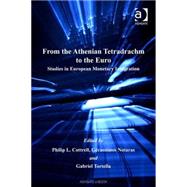From the Athenian Tetradrachm to the Euro
, by Cottrell, Philip L.; Notaras, Gerassimos; Tortella, Gabriel- ISBN: 9780754653899 | 0754653897
- Cover: Hardcover
- Copyright: 7/30/2007
With the introduction of the euro much recent attention has been focused on the role of currencies and their national and international significance. Whilst much has been made of the euro''s achievements in harmonising Europe''s financial dealings, it is often forgotten that it is by no means the first pan-national currency to enter circulation. Indeed, as the various contributions to this volume make plain, the euro can in many ways be regarded as a step ''back to the future'', that is, a further international currency in a long historical tradition. Covering a time span of some two and a half millennia, the contributions within this volume consider aspects of the European experience from classical antiquity until the beginning of the twenty first century. Subjects covered range from early greek currencies, the classical gold standard, the Bretton Woods system and the birth and introduction of the euro. By taking such a long term view of supra-national currencies, this volume provides a unique perspective, not only to the introduction and development of the euro, and its predecessors, but also on the broader question of the relationship between trade and common currencies With the introduction of the Euro much recent attention has been focused on the role of currencies and their national and international significance. Whilst much has been made of the Euro''s achievements in harmonising Europe''s financial dealings, it is often forgotten that it is by no means the first pan-national currency to enter circulation. Indeed, as the various contributions to this volume make plain, the Euro can in many ways be regarded as a step ''back to the future'', that is, a further international currency in a long historical tradition that includes the Athenian tetradrachm, the Spanish escudo and the French franc. Covering a timespan of some two and a half millennia, the contributions within this volume fall within four broad chronological sections, the first comprising three contributions that consider aspects of the European experience from classical antiquity until the high middle ages. The discussion then leaps forward chronologically to the modern age, given a focus by three contributions devoted to nineteenth-century European developments. These, in turn, are set within a wider spatial perspective by two essays that review, first, the classical gold standard, primarily in terms of peripheral economies'' experience, and, second, the Bretton Woods system. Fourth, and lastly, the Euro''s origins and birth are explored in three further contributions. By taking such a long term view of supra-national currencies, this volume provides a unique perspective, not only to the introduction and development of the Euro, and its predecessors, but also on the broader question of the relationship between trade and common currencies. Contents: Preface; From the Athenian tetradrachm to the euro, Theodoros B. Karatzas; Common currency from antiquity: plus Ccedil;a change, plus c''est la mecirc;me chose, Ioannis Touratsoglou; Monetary integration in the Roman Empire, Juan Carlos Martinez Oliva; ''One money for an empire'': achievements and limitations of Byzantium''s currency from Constantine the Great to the fall of Constantinople, Ceacute;cile Morrisson; On the history of German monetary union, Richard H. Tilly; The Latin monetary union revisited once again, Marcello de Cecco; The Scandinavian monetary union 18731924, Lars Jonung; The gold standard: a view from the periphery, Pablo Martiacute;n-Acentilde;a; The Bretton Woods agreements: a monetary theory perspective, Filippo Cesarano; The European monetary system, Michael Artis; European monetary union. A project of promise and risk, Paul De Grauwe; From the Athenian tetradrachm to the euro: some concluding remarks, Vitor Gaspar; Bibliography; Index. About the Author: Professor Philip Cottrell is from the Department of Economic and Social History at the University of Leicester, UK. Gabriel Tortella is from







